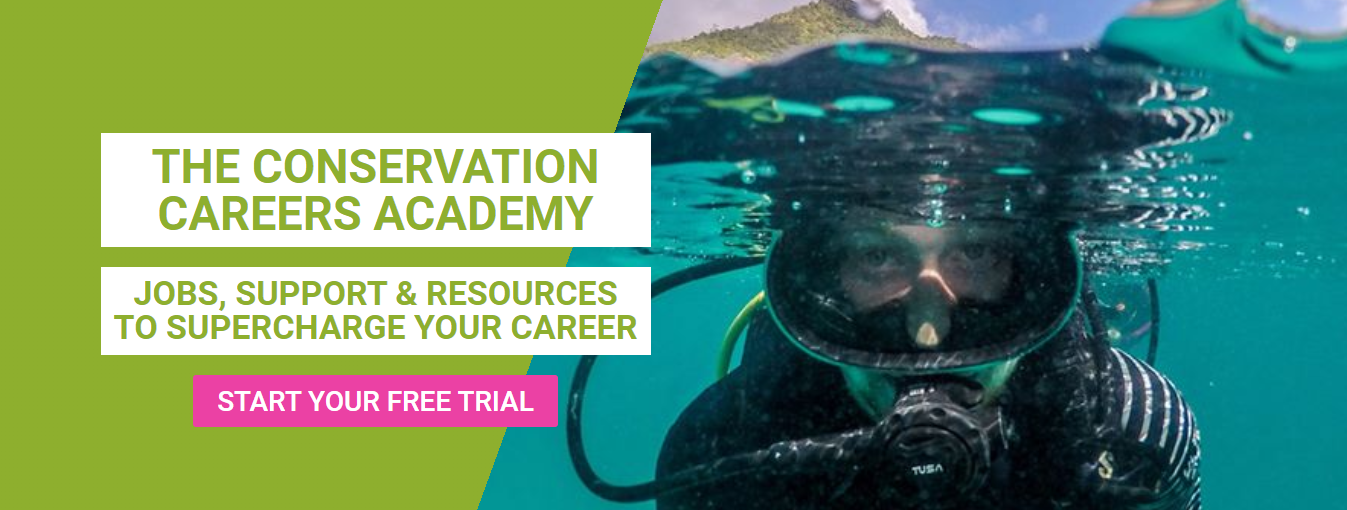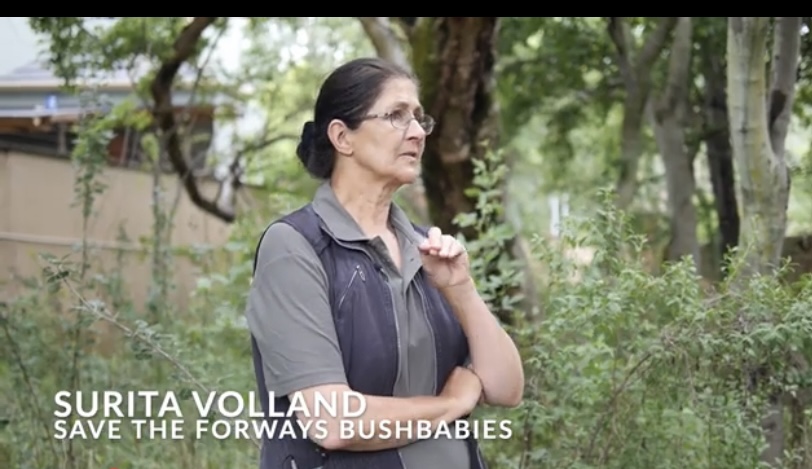
Save the Fourways Bushbabies – An interview with bushbaby conservationist Surita Volland
Surita Volland is a bushbaby enthusiast and, on top of her regular job at Johannesburg airport, the founder of Save the Fourways Bushbabies. This small-scale NPO in Johannesburg, South Africa, is working to save the Fourways land corridor from commercial development – a corridor that the bushbabies have made their home.
Read on to hear about Surita’s conservation journey, the challenges of running an NPO (Non-Profit Organisation), and the highlights of working with bushbabies.
What inspired your love of bushbabies?
I grew up with bushbabies. When we were young, my sister and I spent wonderful holidays with my aunt on a farm in the northwest province. My aunt would put cut fruit out in a bowl on the table and we spent many magical evenings, watching the wild bushbabies jumping down from the tree, through the window, grabbing some fruit from the table and then disappear into the night again.
How did Save the Fourways Bushbabies start?
Green spaces are disappearing at an alarming rate. This particular piece of land is a small, narrow sliver, twenty-five meters wide, which unfortunately was sold to a well-known developer. It will be a huge shame on us to allow the home of the bushbabies [bushbaby corridor], which supports so much indigenous wildlife including the only Fourways bushbaby population, to be destroyed.
We started a petition in June 2019 to try and raise awareness for the bushbabies’ plight, which currently has 96,504 signatures from across the world. At 100,000 signatures, this petition becomes one of the top signed on Change.org. We also had a lengthy court case, and even though the Biodiversity department of City of Johannesburg strongly opposed the development, the development was approved, which is not surprising at all.
Our biggest achievement was when a prominent company indicated that they will not be involved with the proposed development: “due to the community sensitivity and controversy surrounding the current application for the development, it was no longer appropriate for our company to be involved in the project”.
“I mustn’t give up. I must try a little bit harder. I must put more effort [in] and I must keep on because [the bushbabies are] just so special.”
How would you describe your role as an ecologist/conservationist, considering it’s not your main job?
I am very passionate about bushbabies and it is up to us to take action and raise awareness to help protect and save the precious wildlife, such as the bushbabies. The bushbabies are a unique and vulnerable species that is integral to the ecological balance of our community.
Various factors such as habitat destruction and fragmentation as well as urbanisation are a threat to the bushbabies’ survival and is causing a decline in their population.
What is extremely rewarding is that I get calls from as far as Hartbeespoort or even Thabazimbi, where someone found a small bushbaby and then, with the help of our team, we can assist them to try and reunite the baby with the mother.
I even got a call from the Australian embassy in Pretoria (Tswane) that they have a bushbaby in their house. When the bushbaby eventually jumped out of the room, with a makeshift “ladder” to a nearby tree, we could all breathe a sigh of relief.
These experiences are incredibly special and it is living proof that our campaign “Every Bushbaby Matters” and raising awareness for Save the Fourways Bushbabies have gone much further than just the Fourways area where we originated.

Surita with one of the bushbabies she has rescued.
How do you juggle your career with your work with Save the Fourways Bushbabies?
I always joke by saying “Bushbabies are nocturnal like me”, so when I get a call at night about an injured bushbaby or a baby who was found in a garden, I will not think twice to assist. We are an incredible team of men and woman who dedicate our time and resources to caring for and rehabilitating injured or orphaned bushbabies, and we do so with a deep love and respect for every bushbaby we encounter.
I also spend a lot of time researching the bushbabies, such as the 18 different calls they make, which is truly fascinating. Recent studies have indicated that due to fragmentation and urbanisation which causes the bushbabies to form smaller groups away from other groups, that they’ve almost “created” their own dialect.
Their calls include barks, screams, grunts, whistles, and chirps, as well as soft cooing sounds. I can distinguish between a distress call, or when the mother’s calling, or when the baby answers – but there is so much more to learn from the way they communicate with each other and I really wish I could speak bushbaby!
Do you have a conservation background?
I obtained a BSc degree at Potchefstroom University and completed my honours degree at the University of Pretoria.
When we moved to Fourways, the bushbabies crossed my path again and I become involved in the bushbaby corridor project through the Bushbaby SOS foundation. The bushbaby population was declining and their habitat was rapidly disappearing due to urban development in the area.
We planted 700 indigenous trees in the area, mostly along the streets to form bushbaby corridors, which assist the bushbabies with their general wellbeing as well as keeping their gene pools healthy.
“My passion and mission are to secure a future for the Bushbabies of Fourways and to sustain the Bushbaby Corridor for their continued survival.”
What is the best part of working in wildlife conservation?
I think to get a call and speak to somebody that has found us a tiny bushbaby. Normally, we try to get it back to the mother or the group and she will come and fetch the baby just after sunset. If we’re not successful, then we take it to a rehabilitation centre to be integrated with a similar age group of bushbabies and eventually it will be set free.
What is your proudest moment so far?
I think the most amazing learning experience was a seven or eight week period when I was involved in the rehabilitation of a baby bushbaby. He only weighed 42 grams when he was found after a huge storm. We tried to reunite him with his family, but unfortunately it didn’t work out despite our best efforts and he was placed at a bushbaby rehabilitation centre.
I learned so much by sharing this unique experiencing with the specialised care he received around the clock. It was truly amazing to see how much he grew daily, how he started to jump around, when he started making calls, how his instincts work. It was just very, very special.
Maybe you can read and research everything on rehabilitation of bushbabies, but to experience it was on a different level.
And of course, the proudest moment was when he was released successfully back into the wild.
What are some of the challenges of your work and of running on such a small scale?
One of our biggest challenges is funding; most of our projects are self-funded. We have our own ‘bushbaby whisperer’ by the name of Shamba, who’s a tracker. He is absolutely amazing at finding the nests of bushbabies or tracking different groups. He gets to know the groups so well that he can say ‘this one is playing in the tree, and that one is from another group and they were fighting last night’. So yes, funding is important as we would love to employ Shamba full time.
What advice would you have for anybody who wanted to start a local NPO (Non-Profit Organisation) or work in local conservation?
You must have passion for it. If you are passionate about conservation, or you’re passionate about butterflies or bees or bushbabies, you have to find somewhere where you can contribute, either your time or your knowledge or your skill. There are so many organisations that are desperate for volunteers on different levels, so anybody can help.
“I think now especially, after COVID, people realise that there are certain things that you can’t buy with money. We have to look out for the ecology.”
Check out this video about using old ropes to create Bushbaby ‘highways’:
© CityRock
Visit www.savebushbabies.com to learn more and sign the petition.
Author Profile | Jasmine Santilhano
Jasmine Santilhano is an Ecology student at the University of York, UK, and a volunteer Conservation Careers Blogger. She plans to work in wildlife conservation after she graduates.



